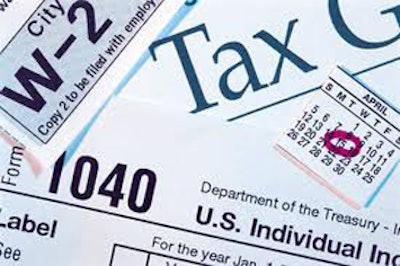
Your business is successful and the days of plowing back profits for growth are in the past. The building and equipment is either paid for or being amortized. The biggest concern now is taxes!
What solution is there and how can the tax bite be minimized?
For most closely-held businesses and professional practices the answer is a tax-deductible “qualified plan” (called “qualified” because the contribution “qualifies” for an income tax deduction). In other words, some form of a retirement plan.
However, a well designed plan is not about retirement, as much as it is about paying yourself rather than Internal Revenue Service! Keep in mind the contributions are income tax deductible, the invested assets grow on a tax-deferred basis, the plan assets are protected from the claim of judgment creditors under ERISA, and the plan assets qualify for an income tax free IRA rollover! 1
The only question is, which plan is best for your particular situation? For the same reason the local car dealership has many different models and colors, plans come in many varieties as well. The reason: one size does not fit all. It’s necessary to choose the right plan for your situation.
Plans come in two general styles, Defined Contribution (DC) and Defined Benefit (DB). Defined Contribution Plans are just that, they define the contribution one can make to the plan. The limits are 25% of covered payroll not to exceed $51,000 for any one individual. Defined Benefit plans define the pension income one will receive at a future date. Adequate funds have to be contributed to provide for that future income.
Frankly, these plans are all budget driven. While we all would like to retire on $1 million a month (wouldn’t that be nice!) the question is do we have the resources to get there? The answer? We all have a budget with which to work. That budget will determine which plan is best for one’s particular circumstances.
Here are some examples:
SIMPLE Plan: For 2013, the maximum pretax employee contribution to a SIMPLE is $12,000. Catch-up contributions for those 50 and older are limited to $2,500. Designed for small business owners who don’t want to deal with retirement plan administration or non-discrimination tests, the SIMPLE is available for businesses with less than 100 employees. The business owner must make fully vested contributions (a dollar-for-dollar match of up to 3% of an employee's income, or a nonelective contribution of 2% of pay for each eligible employee). You cannot sponsor a SIMPLE and another retirement plan.
SEP Plans: This employer-funded plan gives businesses a simplified vehicle for making tax deductible contributions. Employer contributions are 100% vested from the start. In 2013, an employer’s annual contribution limit to a SEP-IRA can’t exceed the lower of $51,000 or 25% of an employee’s salary. The same annual contribution limits apply for the self-employed.
401(k): There are many varieties of the 401(k). Many believe they are all the same but it’s just not that way. For example:
Salary deferral –only structures: This type of plan has no employer contribution. The participating employee may defer 100% of W-2 income not to exceed $17,500 (2013 limits). For those age 50 and older one is allowed an additional $5,500 “catch-up” contribution for a maximum deferral of $23,000
Safe Harbor: Maximum addition to one’s account is $27,700. A byproduct of the Small Business Job Protection Act of 1996, the Safe Harbor plan makes it very attractive to a business owner. With a Safe Harbor plan, an owner-operator can avoid enjoy higher contribution limits. Safe Harbor allows the owners to defer the full salary deferral limits even if employees contribute little or nothing.
Safe Harbor with Discretionary Profit Sharing: Maximum addition to one’s account is $51,000. While the Safe Harbor feature allows the owners to make their full salary deferrals of $17,500 ($23,000 for those 50 and over) the maximum allowable contribution to one’s account is $51,000 ($56,500 for those age 50 and over). Where does the difference come from? The employer’s discretionary profit sharing contribution! The operative word is “discretionary” as the additional contribution is discretionary and there is no obligation to fund from one year to the next. Take advantage of the deduction in profitable years and disregard the contribution when cash is needed for other purposes, such as expansion, etc.
In addition to the above, a 401(k) Plan may have a Roth feature. In other words, the employee’s salary deferral can be made with after-tax monies. The advantage is all the future qualified withdrawals can come out income tax free. Yes the account’s earnings too!
Defined Benefit Plan: When you’ve already done the 401(k) and you need a larger annual income tax deduction, the Defined Benefit plan may be the answer. Consider that these plans allow for annual income tax deductions in some cases of as much as $250,000! But that is the most one can do, you can design the plan for a lesser contribution. As stated earlier in this article, these plans are budget driven, so determine the desired annual contribution and have the plan structured to absorb that amount. One thing about defined benefit plans, the contribution is mandatory. In other words, design with the thought that this contribution must be made for several years.
Planning Myths: Many falsely believe plans do not fit their situation. Only after analysis of the facts and circumstances are the advantages apparent For whatever reason there is a good deal of misinformation circularizing on plans. Don’t assume anything. Have a responsible Pension Consulting firm, in conjunction with your CPA or other competent professional advisor, analyze your circumstances so you can make an informed business decision on what plan is best for you. You may be surprised!
1RMD’s, or required minimum distributions, must commence no later than April 1 of the year following the year one attains are 70 ½. RMD’s are taxable as ordinary income.
William H. Black, Jr. has been in the pension administration business for 34 years. The firm Pension Services, Inc. administers both defined contribution and defined benefit plans, employs an ERISA attorney, an Enrolled Actuary, and complete clerical staff. Bill is qualified to give continuing education to CPA’s in 47 different states. He has spoken nationally and internationally on retirement plans, has been quoted in USA Today, written articles for several industry journals and has appeared on many financial radio shows discussing the topic of retirement and financial matters. He may be contacted at [email protected].
This discussion is not intended as tax advice. The determination of how the tax laws affect a taxpayer is dependent on the taxpayer’s particular situation. A taxpayer may be affected by exceptions to the general rules and by other laws not discussed here. Taxpayers are encouraged to seek help from a competent tax professional for advice about the proper application of the laws to their situation.






















